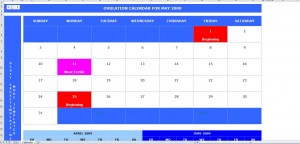
For couples working tirelessly to conceive a child, finding the right ovulation equation can seem like an insolvable mystery.
Conceive and simultaneously align the stars at precisely the right time, and you’re all but guaranteed a perfect pregnancy. Miss that tiny window, however, and your chances start to drop significantly. It’s safe to say that, when the pressure to conceive is high enough, this ovulation equation can be somewhat stressful for future mom’s and dad’s.
But while we tend to associate the chances of conception as purely the hand of Mother Nature, when given the right tools, it’s entirely possible to analyze the art of conception as a kind of mathematical algorithm, capable of being documented and duplicated.
And one of the easiest, most concise equations for guaranteeing conception is through precise tracking with an ovulation calendar. By documenting your monthly periods, women can record their menstrual cycle’s beginning and end, as well as plan for the days of her most heightened state of fertility.
Tracking Dates with the Ovulation Calendar: It’s All About Timing
Prior to the explosion of birth control, most women associated their menstrual cycles with the whim of nature, incapable of control or predictability. However, as drug and medical technology have advanced through the ages, women have gained the ability to not only control their periods, but to plan their fertility around them as well. And this planning can be achieved directly through an ovulation calculator or calendar, individualized to a woman’s specific cycle.
The first step towards creating a thorough, accurate calendar is to record the most important dates of your menstrual cycle, including:
- The beginning of your last menstrual cycle. Our printable ovulation calendar contains an area to record this date. The average cycle lasts anywhere from 28 to 32 days.
- The duration of your average menstrual cycle period.
- Your luteal phase period. The luteal phase begins day after ovulation and lasts through the duration of the monthly cycle, typically spanning 12 to 16 days.
- The displayed month. You can interchange the ovulation calendar for each specific month.
- The displayed year. You can interchange this date as well.
Recording these dates is absolutely critical for an accurate assessment of your fertility. One missed recording, as seemingly insignificant as it may appear, can mean the difference between peak fertility, and a conception crux.
Solving a Confusing Pregnancy Equation
Understanding the most important dates of your menstrual cycle can improve your chances of getting pregnant tenfold. But how to analyze this info can be a bit of a conundrum for couples attempting to conceive.
Most generally, the menstrual cycle within your ovulation calendar can be separated into specific phases. The first phase commences with your monthly period, or shedding of the uterus line. Your body is expelling hormones to stimulate egg growth within your ovary follicles. And between the second and 14th day of the ovulation cycle, those hormones aid in thickening the mucus-like wall lining your uterus, preparing for the implantation of a fertilized egg.
In conception terms, this is considered the follicular stage, and it’s a period where your chances of getting pregnant are slim.
Ovulation, on the other hand, will occur between the 11th and 21st day of your ovulation cycle. Hormonal changes within your body trigger the release of an egg that’s the most ripe for taking, while your cervical mucus moves to a more slippery, liquid-consistency, capable of providing a fast-track for sperm to reach their destination.
The highest change of conception, and the times when you will be most fertile, will occur one to two days prior to ovulation.
As a general rule of thumb, couples looking to conceive should count back 14 days in their ovulation calendar, and hone in on a few days to prioritize sex. However, no two ovulation periods are mirror images of one another, so women will need to identify on their ovulation calendars how the length of their menstrual cycles correspond with their individual ovulation periods.
Also, consider opting for engaging in intercourse every other day, as a man’s sperm count will be at its peak when well rested.
While the art of getting pregnant tends to be an incredibly intimate period for couples, the science behind conception shouldn’t be a topic entirely shied away from. Download the Ovulation Calendar from ExcelTemplates.net and begin aligning your perfect pregnancy stars today.
Download: Ovulation Calendar
Related Templates:
- Ovulation Calculator
- Ovulation Predictor
- Fertility Calendar
- Basal Body Temperature Chart
- Chinese Gender Calendar
View this offer while you wait!
